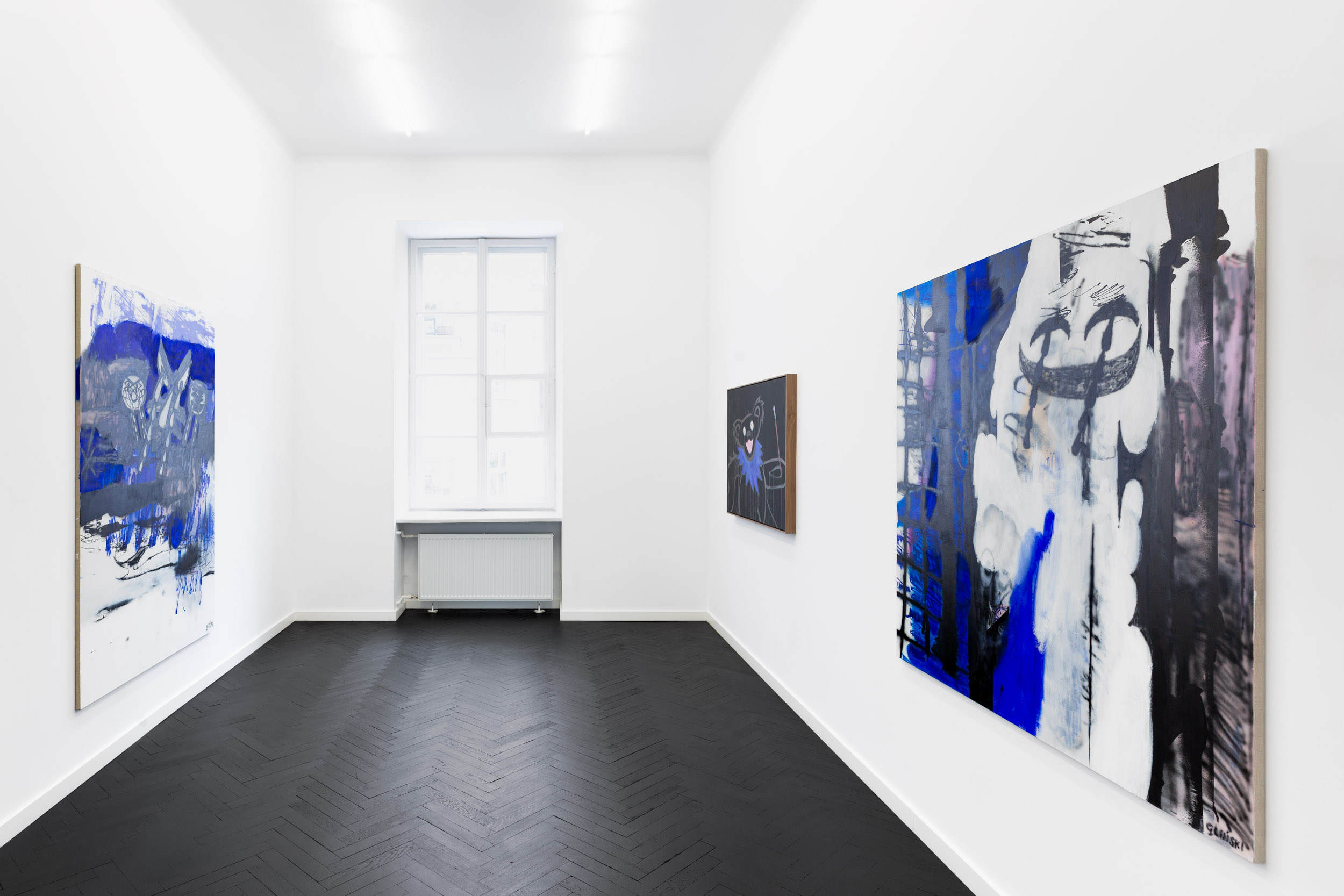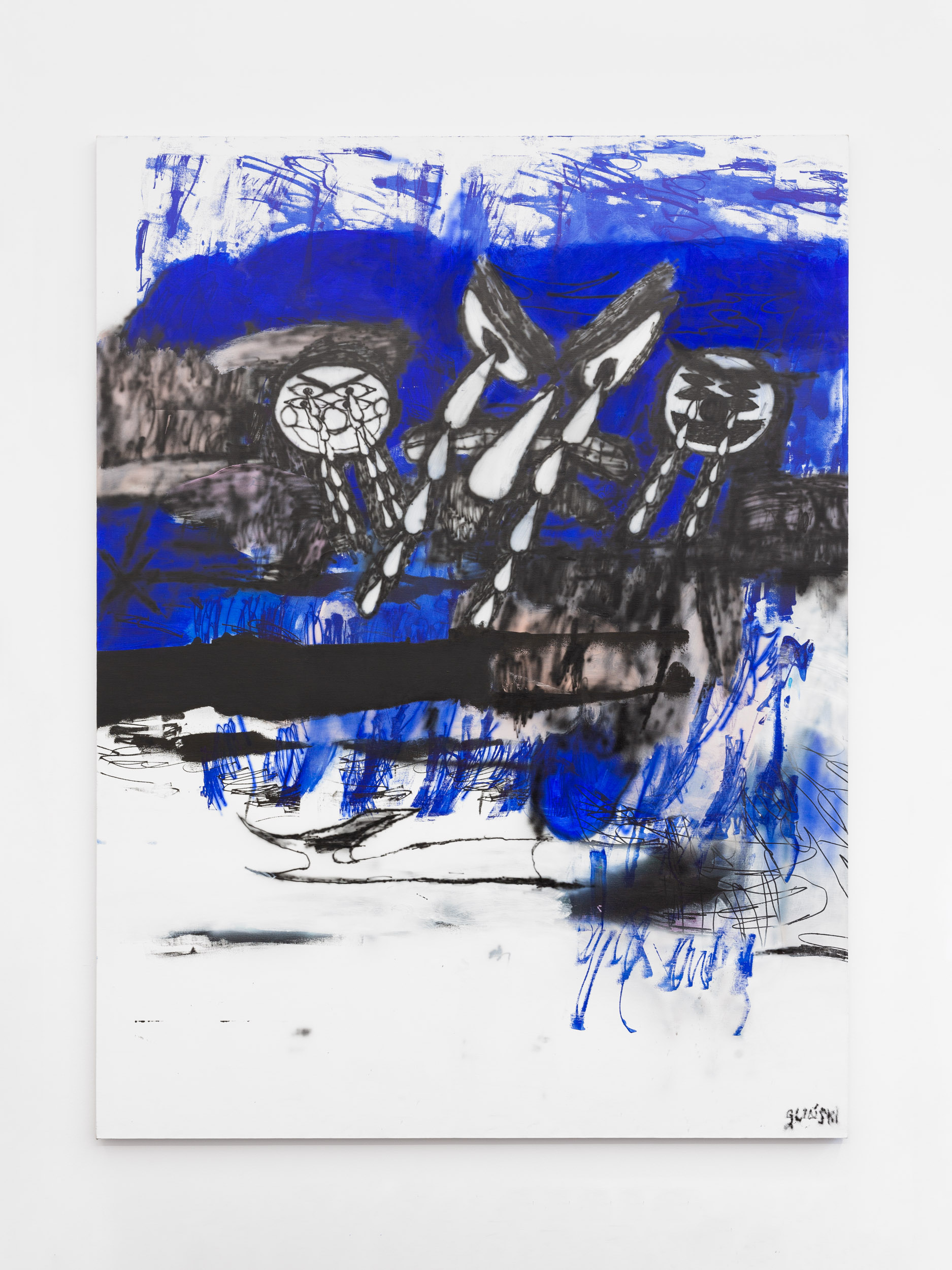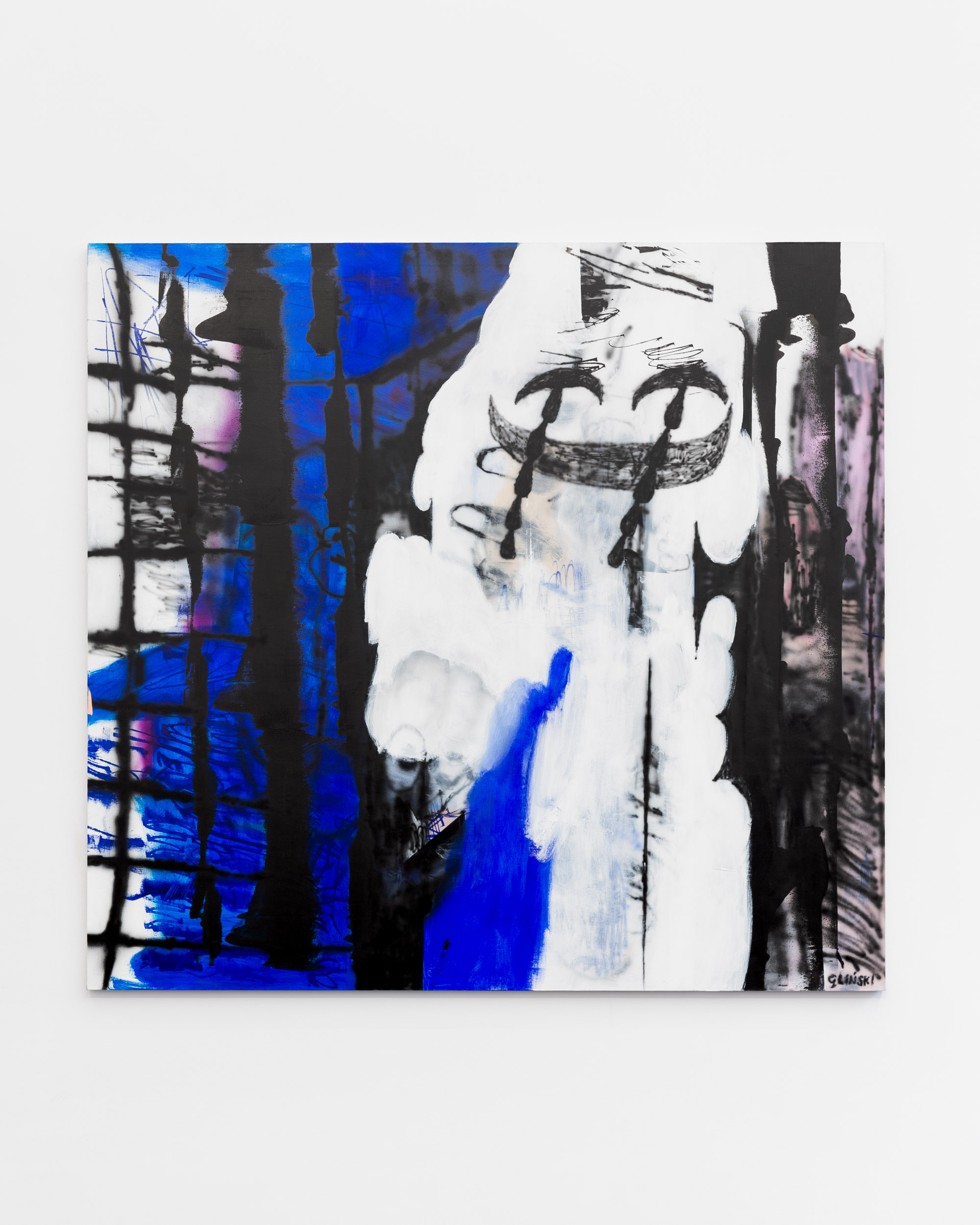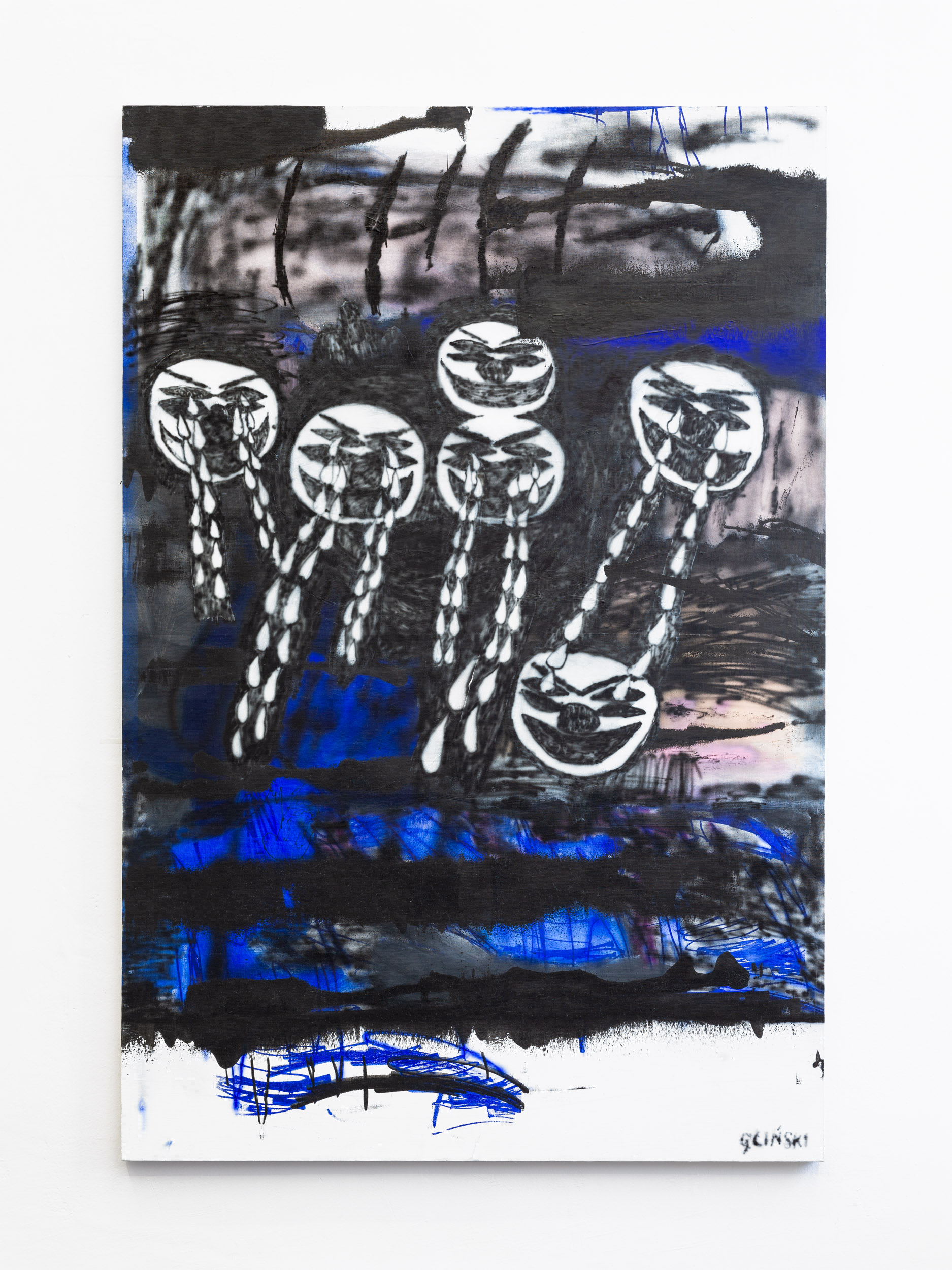Constellation 2024
Gunia Nowik Gallery × Société, Berlin
Tina Braegger
Jakub Gliński
Worst Case Scenario
Apr 6 – May 11, 2024

We are very pleased to host Berlin-based gallery Société as part of the gallery-sharing initiative Constellation in Warsaw. Together, we cordially invite you to a duo-show featuring Swiss artist Tina Braegger and Polish artist Jakub Gliński, both from the same generation. The exhibition titled Worst Case Scenario fosters a dialogue between two practices, provoking reflection on the paradoxical nature of abundance and the erosion of meaning in the face of relentless replication. A text by Post Brothers is accompanying the show.
Tina Braegger, born in 1985 in Lucerne, Switzerland, is a conceptual artist whose work addresses questions related to originality, reproduction, authenticity, repetition, and difference. Since 2017, she has explored these topics through the motif of the „dancing bear,” a bootleg drawing that became an emblem of the American rock band The Grateful Dead in the 1970s. Braegger’s attraction to the bear has little to do with the band‘s music. Instead, her painting practice conceptually engages with how this counterfeit symbol inverts notions of official and unofficial, original and copy. In Braegger’s paintings, as in the concert parking lots that spawned countless variations of this figure, the bear operates according to the logic of the bootleg. The dancing bear absorbs, sponge-like, characteristics that it encounters through the process of its circulation, canonization, and its own fluctuating values—which Braegger addresses in her endless painterly permutations of this figure. As critic Francesco Tenaglia notes, „It is always there, in one form or another, and it defines the way painting reinvents it, reacts against it, ignores it, or digests it. It is a logo, a mannerism, a trigger, and a grid. She lives and works in Berlin and Zurich.
Jakub Gliński, born in Rzeszów, Poland, is a painter, performer and audiovisual artist creating a total and radical oeuvre. His inspiration and domain is destruction, decay and civilisational waste. His performances may be seen as theatrical acts, often reaching the extreme and leaving the audience in a state of deep shock. He usually creates his paintings and installations intuitively, using the expression-rich aesthetics of “Trash and Error”. A grey-blue palette with the use of an airbrush, intermingling fields of colour that resemble scratched walls, visual quotations drawn from murals, pop culture, tattoos or children’s drawings have become the artist’s clearly recognisable style. His artistic activities in many fields are a rapid, often subconscious reactions to the signals he “receives” from his surroundings. Jakub Gliński is also a creator of projects: SUPER AIDS, Galeria Śmierć Frajerom, Jesus Is A Noise Commander, Jakub Gliński & PURGIST, KURF, Too Empty To Poo, BOOM FOR GABBA and Igenn Xew. He lives and works in Warsaw.
Special thanks to Syrena Real Estate and HOP Chmielna for supporting the exhibition.

Worst
Case
Scenario
Post Brothers
What really happened was that everybody was squabbling over the apple and working up a sweat and pushing one another around and pretty soon their vibrations – Gods have very high vibration, exactly at the speed of light, in fact – heated up the apple enough to unleash some heavy fumes. In a word, the Olympians all got stoned.
And they saw a Vision, or a series of Visions.
In the first Vision, they saw fire. A raging inferno. They watched as an endless series of different homes were engulfed in flames and burnt to the ground. Sparked by distinct circumstances and blazing in dissimilar ways, the only detail connecting the backdrafts was the presence of the same painting in every household, which made it through the fires completely unscathed. The image was a mass-produced print of a painting of a wide-eyed toddler with tears flowing from his rosy cheeks, purportedly painted by the Florentine Giovanni Bragolin, also known as Bruno Amadeo. The firefighters surveying the charred ruins had come to believe that the image was cursed, that either the crying boy had kindled the mysterious infernos or that his tears had put the fires out. Nevertheless, that kitschy painting remained intact. The populace began to fear this image and organized public bonfires of the icon, but of course, they failed to destroy the cheap prints. “It could be worse,” said one of the bystanders, “it could’ve been a Banksy.”
And that was the first Vision.
In the second Vision, the sky was falling. No, this was not a scenario of a hysterical little chicken who is hit by a falling acorn. The sky was progressively lowering, as if the heavens and the earth were drawn together with a magnetic force. You know those days where the clouds hang so low that it becomes a flat, featureless, uniform layer of grey? This was worse, much worse, as if existence itself was being crushed. The movement was subtle but noticeable, and the people had to get on with their lives despite the looming catastrophe. Humans especially were somehow devolving, slowly lowering their backs, returning to their horizontal origins, spreading width wise, moving laterally. Shorter people and other things were of course at an advantage, but even they eventually had to readjust their postures. While some just laid back, the city was full of crawling and wriggling individuals. Eventually there was no longer a horizon, the curtain was almost down. Squeezed between nothingness and a sliver of somethingness, a woman opined, “this is depressing”. Her daughter replied, “It could be worse, we could be brought back for a final bow.” Fade to black.
And that was the second Vision.
In the third Vision, they saw an artist reading a book on Yogic meditation. The man arose, opened his door, and walked out into a dense forest. After much perambulation, the artist stopped at an unremarkable tree, no more special than any other in the woods. “This is the one,” he mumbled to himself in satisfaction. He sat down and meditated at its base for an immeasurable amount of time, and then, without pomp nor circumstance, reached into his satchel and produced a pad of paper and a pencil. After drawing the tree’s portrait, he got up and walked home. This plein-air routine would continue every day for many years. The Gods observed the man devoting his entire days to that one ordinary tree, it had become his muse, his spiritual avatar, a tool for mindfulness, and the singular subject of his entire catalogue raisonné. Thousands of novel and diverse images were produced. There was nothing special about that one plant, it was quintessentially insignificant, it had even been cloned, genetically identical to all its neighbours. Yet this man had looked out into the woods, and from all the woody plants, he chose that one, that tree to build his oeuvre. Apparently, he couldn’t see the forest for the trees. It could be worse.
And that was the third Vision.







In the fourth Vision, they found themselves in the workshop of a celebrated charcutier, a salumiere second-to-none, the world’s greatest wurstmeister. The sausage-maker had long moved beyond mere minced flesh, forcemeats, and fillers, instead he had devised a remarkable system for encasing everything and anything into cleared animal intestines. These were not your dog’s sausage, his ingredients spanned across the neo-platonic hierarchy of substances, disregarding logics of scale and edibility to concoct the most delicious hot dogs one can imagine. For example, these were the constituents of his latest banger: Gingerbread, a windmill, a baby blanket, North Carolina, a horse with hooves, Pikachu, the heart of a virgin set into aspic, blue almonds, a Juggalo, a transistor radio, climate change, an isotope of thulium, and grandma’s dentures. Yet somehow, each melange was unquestionably a sausage. The butcher’s motto: “it could be wurst.”
And that was the fourth Vision.
In the fifth Vision, they were back in the woods, but were in for a big surprise. Beneath the trees where nobody sees, they heard a rustling, and went to investigate. At a secluded clearing, every bear that ever there was, gathered there together because today’s the day the teddy bears have their picnic. “Welcome home” a grizzly growled. “Hey now!” a sleuth of ursids roared. Everyone was there: Wojtek, Paddington, Winnie-the-Poo, Bely Mishka, Ungnyeo, Fozzie Bear, Balloo, Teddy Floppy Ear the care bears and those ones from Haribo, and certainly every panda, black bear, brown bear, and polar bear, even Bojan, the Slovenian superstar who paints his own world with three colours. Every bear that ever there was. Even a whale had arrived. “A distant cousin,” explained one of them, who considered himself smarter than the average bear. As the Germans say, Da steppt der Bär (the bear is dancing here). The teddy bears were having a lovely time today, those magical marchers loved to play and shout, it was the furriest and musky party imaginable. That’s the way the teddy bears have their picnic. Zeus was kissing that bear again, he had promised himself, “Never again,” but here he was, kissing that damn bear. “You need Jesus,” said his wife Hera. At some point, a lumbering bruin asked for a miracle, and the Olympians obliged, but it felt like it was a burden. “It could be worse,” Artemis observed, “we could’ve asked him for a favour, and gotten a real bear’s service.
And that was the fifth Vision.
In the sixth Vision, a man visits a doctor. He says that he’s manically depressed. He explains that life seems barbaric, dark, and cruel. He feels all alone in a threatening world where what lies ahead is vague and uncertain. It happened one day that he fell in love with a girl, but he did not know how to confess to her. He has such a tender heart, but he’s like a broken jug. The wretchedness of the world had left him alienated, imprisoned, hopeless, and unable to understand the world as it is. The doctor responds, “Your treatment is simple. You must go to Warsaw and see the great Stańczyk at the court, a masterful humorist, free and wise, a true lover of life. Go and see him, he will surely pick you up.” The man bursts into tears. “But doctor… I am Stańczyk!” A clown, a clown in love, he has such a tender heart.
And that was the sixth Vision.
And now the Olympians were coming down and they looked at each other in uncertainty and dismay. Zeus himself spoke first:
— Man — he said — that was Heavy Grass.
— Far fuckin out — Hermes agreed solemnly.
— Tree fuckin mendous — added Dionysius, petting his lynx.
— We were really fuckin into it — Hera summed up for all.
Everyone fell asleep. In their dreams, a phrase echoed: Eadem mutata resurgo (I arise again the same though changed)






The inaugural edition of the gallery-share event Constellation takes place on April 6 – 7, 2024, featuring leading Warsaw art galleries and invited galleries from abroad. BWA Warszawa, Foksal Gallery Foundation, Monopol, Gunia Nowik Gallery, Piktogram, Dawid Radziszewski, Raster, Stereo, Turnus, and wanda present exhibitions conceived in cooperation with partners from Berlin, Brussels, Bucharest, London, Paris, Tbilisi, and Vienna. Carefully curated presentations aim to provide a comprehensive view of the local art scene within an international context.
Warsaw is undeniably one of the most important centers of contemporary art in Europe. It is distinguished notably by its thriving community of private galleries, which effectively animate the everyday artistic life of the capital and Polish art market. The gallery-share model, which enjoys global recognition, serves as an effective mechanism for amplifying the visibility of art gallery activities. Constellation is an artistic, social, and commercial event – echoing the main goals and features of the dynamic institutions we are running.
The essence of Constellation is cooperation with guests from abroad and their contribution to the shape of the event; the experience gained and alliances established on this occasion will allow us to set further horizons in a broad international perspective.
Invited galleries from abroad: Galerie Berinson / Berlin, Collective Ending / London, Emalin / London, Exile / Vienna, Exo Exo / Paris, Hot Wheels / Athens / London, Ivan Gallery / Bucharest, KIN / Brussels, LC Queisser / Tbilisi, Persons Projects / Berlin, Anca Poterasu / Bucharest, Société / Berlin
Organizers: Piktogram, Dawid Radziszewski Gallery, Stereo
Technological Partner: Artsaas
Media Partners: Vogue, DesignAlive, Artinfo.pl, Art Viewer
www.constellation.org.pl